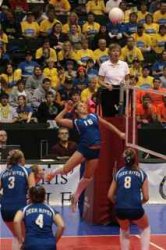Alright, lets get realistic here...
One - for sports you need to have a fast shutter speed, and if your in a gym for highschool or what not you can't blind players with continual flashes (seriously, try shooting a flash or two off every 5-10 seconds and see how annoyed people will be).
Two - your using a D80 (I do too), your going to need at least f/2.8 or lower. Reason, beyond ISO400 the D80 has a habit of producing too much grain for action shots (grain is not good for action - unless there is a lot of it and you mean to add it).
Go Prime, Zooming in and out can be done with cropping.
50mm f1.4, 50mm f1.8, or 85mm 1.4 should be your main options (some people mentioned them already). If your far away from the action, or close-ups are what you going for than 105mm f2.8 can be an good second lens for that situation. There is also f/1.2 option I use but its rare and pricey, so your stuck with those other lens options.
At the end of the day realize that without pro-gear your going to have trouble getting 'pro' results, your pictures will still be awesome, but you wont get that last 5% quality that people who spend ten of thousands of dollars on, but with the above mentioned lens and your D80, 95% aint bad!


